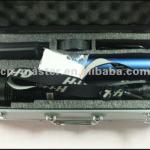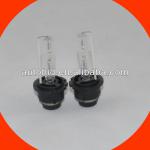GL-RG-160 160W Toroidal Xenon Flash Lamp For Professional Studio Strobe Replacement Light Bulb Tube - GL-RG-160
| Place of Origin: China (Mainland) | Brand Name: Glan/OEM/ODM | Model Number: GL-RG-160 | Specification: R1 |
| Color: Clear | SKU: GL-RG-160 | Shape/Fig: R1 | Anode to Cathode Voltage: Min 220 Nom 315 Max 400 |
| Trigger Voltage(KV)MIN: 6 | Max Energy Per Flash(WS): 100 | Max Flash Rate(s): 5 | Nominal Life(No. of Flashes): 1x10 4 |
| Voltage Across Primary(V): 190 | Trigger Capacitor(uF): 0.1 |

Item Name:
GL-RG-160 160W Toroidal Xenon Flash Lamp For Professional Studio Strobe Replacement Light Bulb Tube
Applicable To: Photographic
Xenon flashtubes emit a high intensity light ideal for a broad range of applications: Photographic : Both amateur and professional equipment.Traffic : Warning beacons for traffic control, aircraft, marine craft, emergency vehicles, airport runways and railroads.Industry : Stroboscopic applications such as automotive timing lights, dynamic balancing machines, high speed photo copiers and typesetting.Publicity: Strobes for window displays, psychedelic lighting.Science: Stroboscopic applications, laser pumping, colorimetry.Medicine: Endoscopic applications.
A Full Line
We offer a full line of high quality, high performance flashtubes ranging from small linears to high-powerd helical, linear, ring and U-shaped lamps.
Long life
High temperature seals, advanced cathode technology and high temperature processing guarantee consistently superior products. All lamps are individually tested for trigger and light output characteristics before shipment.
Reproducible Production Quality
Unique high temperature processing, using highly sophisticated equipment, assures extreme raliability and reproducibility for both small and large production quantities.
High Light Output
These flashtubes are designed to provide highest possible optical output within UV. visible and IR region. Color temperature of emitted light can be controlled for different applications.
Flashtube Construction
In principal the construction of the flashtube is quite simple. A glass or quartz tube is configured to the appropriate shape, filled with Xenon gas, and an electrode is sealed in at each end. Then, a means of triggering the tube . .
such as a wire wrapped around the outer diameter . . is devised. Of course,
the performance of such a tube is dependent upon things such as:
. Type of glass or quartz envelope
. Arc length or tube diameter
. Electrode design
. The Xenon gas pressure and composition
. The method of triggering the flash.
Flashtube Circuitry
To operate the flashtube, a circuit such as the one shown in figure 1 can be used.
The operation of the circuit is as follows:
A, Capacitor CS in parallel with the flash tube is charged by a voltage source.
B, Capacitor Ct is charged to its proper potential by tapping into a voltage divider consisting of resistors R1 and R2
C, The primary of the trigger coil Tr and switch S are connected in parallel to the capacitor Ct and the secondary of the trigger coil is attached to the flashtube trigger wire.
D, When switch S is closed, capacitor Ct discharges through the trigger coil causing a high voltage pulse around the outside of the flashtube.
E, This pulse produces an ion path in the Xenon gas, thus greatly lowering the resistance between the electrodes and flashtubes.
F, Once this resistance is lowered, the capacitor Cs discharges across the tube.
G, The electron flow caused by this capacitor discharge excites some of the electrons in the Xenon gas molecules to a higher energy state, or in many cases removes the electrons completely ( ionizes them) from the molecule.
H, When these electrons return to the ground state, energy is released in the form of light.
Input Energy and Power
Light Output - The light output of a flashtube is a function of the electrical energy stored
in the storage capacitor. This energy is given as . .
.E=1/2CV2
Where E = Energy in Watt seconds or Joules
C= Capacitance of storaqe capacitor in farads
V= Anode potential in volts
| V | dc Operating Voltage |
| CS | Energy Storage Capacitor |
| R1,R2 | Resistors Used for Dividing Voltage |
| CT | Trigger Capacitor |
| L | Choke (required only when MP storage capacitor is used) |
| Tr | Trigger Coil |
| S | Switch |
| FT | Flashtube |
Average Power - The average power dissipated by a flashtube can be expressed as . . .
Wavg. = Ef
Where E = Energy in Watt Seconds or Joules
f = Flash rate in Hz
It is important in flashtube design to consider not only the maximum energy per flash but also the average power. The flashtube has a maximum rate at which it can dissipate heat, and the heat produced by the flash-tube is proportional to the average power. This means that at higher flash rates the energy per flash must be reduced.
Spectral Output
The Xenon flashtube emits light from roughly 0.2 microns in the UV to about 2.0 microns in the near IR, and has peaks at about 0.48 microns and 0.8 microns.The visible region of the spectrum falls roughly between 0,4 microns and 0,7 microns,
The color temperature normally corresponds to a black body at between 6000K and 7000 K,
When current density through the flashtube is increased, there is spectral shift to lower wave lengths (blue).
The current density is dependent upon the tube diameter, the input energy to the tube, and the capacity for discharge time.
| Packaging Detail:Inner protection foam packed by small box, and outer natural packing cartons |
| Delivery Detail:Within a Week |














